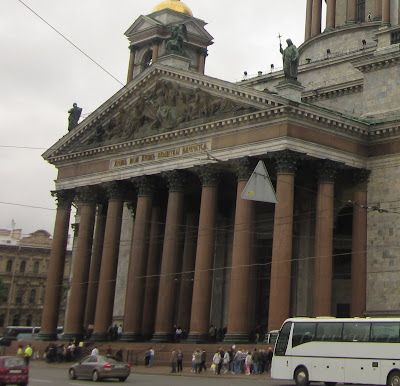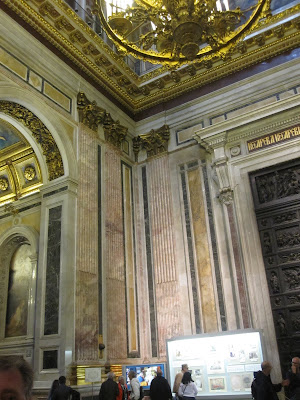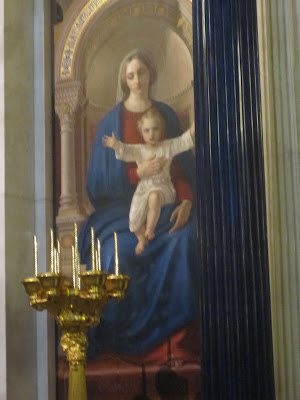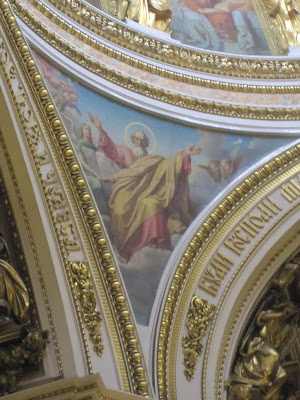Saint Isaac’s Cathedral in St. Petersburg, Russia,
is the second tallest Eastern Orthodox Church behind the Cathedral of Christ the Savior in Moscow. Saint Isaac was the founder of the Dalmatian Monastery
who died in 383 and whose feast day was the birthday of Peter the Great, who ruled Russia from 1682 to 1725. Peter the Great commissioned the first church that originally stood near the same spot in 1710 and called it St. Isaac’s. The first St. Isaac’s was too close to the river and was destroyed by floods. A second St. Isaac’s, built of stone, but with inadequate foundations, was built on the spot where the Bronze Horseman is located
(across the street).
It was crumbling and then destroyed by fire. Catherine II commissioned a third St. Isaac’s on the current location, but it was not completed for various reasons, including the death of the architect and of Catherine II, and the succeeding emperor, Paul I, used marble slated for the cathedral in his new castle. Tsar Alexander I, who disliked the structure, had it torn down and held a national competition for the fourth version of St. Isaac’s. The design of a French architect, Auguste de Montferrand, was selected and Montferrand spent the rest of his life, 40 years, from 1818 to 1858, building the cathedral (he died just a few weeks after it was completed).
In my post on Helsinki Cathedral, I noted that Helsinki Cathedral was inspired by St. Isaac’s and it is interesting to compare them and see the similarities. There is a model of St. Isaac’s inside the cathedral which makes it easier to see the architectural points.
St. Isaac’s is a Greek cross with a square central mass and four arms of equal length, each marked by a colonnade and pediment.
It has a central dome with four small domes in a square below it
with statues of the twelve apostles at apexes and corners on each pediment.
The exterior uses gray
and pink stone,
including red granite columns (made of single pieces of granite) with Corinthian capitals.
The dome is decorated with statues of angels and is plated with pure gold. Native materials were used in building the cathedral. In fact, a bust of Auguste de Montferrand, made of marble, granite, porphyry, shale and quartzite, all materials prominently used in the cathedral, is in the cathedral.
Note similar materials
and colors
in the floor tiles
and beautiful wall paneling.
Fourteen kinds of marble
are used, as well as jasper.
The iconostasis has eight columns of semiprecious stone:
six of malachite (the green) and two smaller ones of lazurite (the blue). Framed by the iconostasis is a brightly colored stained glass window of the resurrected Christ.
It is unusual not only because stained glass windows are rarely used in Orthodox churches, but also because Christ is dressed in Catholic red rather than Orthodox blue. A door inside of the lazurite columns leading to the stained glass window of Christ.
Christ above the arch on the iconostasis.
Christ to the right of the stain glass in the iconostasis.
The Virgin Mary, on the direct opposite side of Christ, on the iconstasis.
The south portico has huge doors
made of electroplated
cast bronze
over solid oak, with reliefs on them
patterned after the doors on the Baptistery in Florence
designed by Lorenzo Ghiberti.
The interior originally was decorated by paintings,
but they began to deteriorate.
So Montferrand ordered them to be reproduced as mosaics, which would survive better in the cold, damp conditions inside the cathedral.
The conversion from paintings to mosaics was not fully completed. There are a number of uninstalled mosaics on the floor
and I’m not sure
if they were just never installed.
For example, there is an uninstalled mosaic of Christ in the air
and what appears to be a painting of the same scene on the wall framed by marble.
Close-ups of the mosaics
reveal how intricate
and wonderful they are.
The use of mosaics was later taken to another level in the Church of the Savior on Spilled Blood which contains no paintings, just mosaics. The cupola
has a painting
of the Virgin Mary
surrounded by saints and angels.
Below the painting of the Virgin Mary, still inside the cupola, are gold angels and paintings of apostles.
In the triangles
formed where the vaults meet the cupola
are additional paintings (or mosaics?).
During Soviet rule, St. Isaac’s was turned into a Museum of Scientific Atheism and a pendulum was hung from the center of the dome, ostensibly to demonstrate the earth’s rotation. With the fall of communism, the museum was removed and St. Isaac’s was restored to use again by the Russian Orthodox Church. A silver bronze dove,
a symbol of the Holy Spirit and peace, was restored to the center of the dome. Current worship services are held primarily in the left side chapel.
However, the main portion of the church is used for worship services on major ecclesiastical occasions and it can accommodate 14,000 standing worshipers. Finally, a painting of the Virgin Mary and Christ child.
St. Isaac's is another amazingly beautiful Russian Orthodox church which has few other rivals for beauty, particularly inside, in the world.





















































In a church full of beautiful paintings and art, I think those mosaics are especially amazing.
ReplyDeleteTo Get The No #1 Painter In Florida Click On The Link
ReplyDelete